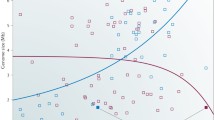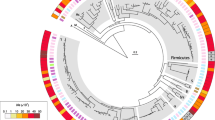Abstract
Genome reduction has been considered the hallmark of endosymbiotic bacteria, such as endocellular mutualists or obligatory pathogens until it was found exactly the same in several free-living bacteria. In endosymbiotic bacteria genome reduction is mainly attributed to degenerative processes due to small population size. These cannot affect the free-living bacteria with reduced genomes because they are known to have very large population sizes. It has been proposed that selection for simplification drove genome reduction in these free-living bacteria. For at least one of them (Prochlorococcus), genome reduction is associated with accelerated evolution and we suggest an alternative hypothesis based on increase in mutation rate as the primary cause of genome reduction in free-living bacteria.


Similar content being viewed by others
References
André JB, Godelle B (2006) The evolution of mutation rate in finite asexual populations. Genetics 172:611–626
Biebricher CK, Eigen M (2005) The error threshold. Virus Res 107:117–127
Coleman ML, Sullivan MB, Martiny AC et al (2006) Genomic islands and the ecology and evolution of Prochlorococcus. Science 311:1768–1770
Cox EC, Yanofsky C (1967) Altered base ratios in the DNA of an Escherichia coli mutator strain. Proc Natl Acad Sci USA 58:1895–1902
Dagan T, Blekhman R, Graur D (2006) The “domino theory” of gene death: gradual and mass gene extinction events in three lineages of obligate symbiotic bacterial pathogens. Mol Biol Evol 23:310–316
Dale C, Wang B, Moran N et al (2003) Loss of DNA recombinational repair enzymes in the initial stages of genome degeneration. Mol Biol Evol 20:1188–1194
Denamur E, Lecointre G, Darlu P et al (2000) Evolutionary implications of the frequent horizontal transfer of mismatch repair genes. Cell 103:711–721
Dufresne A, Salanoubat M, Partensky F et al (2003) Genome sequence of the cyanobacterium Prochlorococcus marinus SS120, a nearly minimal oxyphototrophic genome. Proc Natl Acad Sci USA 100:10020–10025
Dufresne A, Garczarek L, Partensky F (2005) Accelerated evolution associated with genome reduction in a free-living prokaryote. Genome Biol 6:R14
Eigen M (1971) Selforganization of matter and the evolution of macromolecules. Naturwissenschaften 64:465–523
Gerrish PJ, Colato A, Perelson AS et al (2007) Complete genetic linkage can subvert natural selection. Proc Natl Acad Sci USA 104:6266–6271
Giovannoni SJ, Tripp HJ, Givan S et al (2005) Genome streamlining in a cosmopolitan oceanic bacterium. Science 309:1242–1245
Haigh J (1978) The accumulation of deleterious genes in a population—Muller’s Ratchet. Theor Popul Biol 14:251–267
Itoh T, Martin W, Nei M (2002) Acceleration of genomic evolution caused by enhanced mutation rate in endocellular symbionts. Proc Natl Acad Sci USA 99:12944–12948
Kurland CG, Andersson SG (2000) Origin and evolution of the mitochondrial proteome. Microbiol Mol Biol Rev 64:786–820
Lynch M (2006) The origins of eukaryotic gene structure. Mol Biol Evol 23:450–468
Lynch M, Conery JS (2003) The origins of genome complexity. Science 302:1401–1404
Mackay WJ, Han S, Samson LD (1994) DNA alkylation repair limits spontaneous base substitution mutations in Escherichia coli. J Bacteriol 176:3224–3230
Martiny AC, Coleman ML, Chisholm SW (2006) Phosphate acquisition genes in Prochlorococcus ecotypes: evidence for genome-wide adaptation. Proc Natl Acad Sci USA 103:12552–12557
Mira A, Ochman H, Moran NA (2001) Deletional bias and the evolution of bacterial genomes. Trends Genet 17:589–596
Moran NA (2002) Microbial minimalism: genome reduction in bacterial pathogens. Cell 108:583–586
Rocap G, Larimer FW, Lamerdin J et al (2003) Genome divergence in two Prochlorococcus ecotypes reflects oceanic niche differentiation. Nature 424:1042–1047
Rocha EP, Danchin A (2002) Base composition bias might result from competition for metabolic resources. Trends Genet 18:291–294
Saumaa S, Tover A, Kasak L et al (2002) Different spectra of stationary-phase mutations in early-arising versus late-arising mutants of Pseudomonas putida: involvement of the DNA repair enzyme MutY and the stationary-phase sigma factor RpoS. J Bacteriol 184:6957–6965
Sniegowski PD, Gerrish PJ, Lenski RE (1997) Evolution of high mutation rates in experimental populations of E. coli. Nature 387:703–705
Taddei F, Radman M, Maynard-Smith J et al (1997) Role of mutator alleles in adaptive evolution. Nature 387:700–702
Tenaillon O, Toupance B, Le Nagard H et al (1999) Mutators, population size, adaptive landscape the adaptation of asexual populations of bacteria. Genetics 152:485–493
Tenaillon O, Le Nagard H, Godelle B et al (2000) Mutators and sex in bacteria: conflict between adaptive strategies. Proc Natl Acad Sci USA 97:10465–10470
Vulic M, Dionisio F, Taddei F et al (1997) Molecular keys to speciation: DNA polymorphism and the control of genetic exchange in enterobacteria. Proc Natl Acad Sci USA 94:9763–9767
Wiehe T (2000) Model dependency of error thresholds: the role of fitness functions and contrasts between the finite and infinite sites models. Genetical Research 69:127–136
Acknowledgements
We thank Siv Andersson, Vincent Daubin, and Eduardo Rocha and Pierre Alexis Gros for helpful comments on this manuscript. G.M. is a CNRS fellow, A.C. has a PhD fellowship from the French ministry of research and O.T. was funded by Agence Nationale de la Recherche grant (ANR-05JCJC0136-01).
Author information
Authors and Affiliations
Corresponding author
Rights and permissions
About this article
Cite this article
Marais, G.A.B., Calteau, A. & Tenaillon, O. Mutation rate and genome reduction in endosymbiotic and free-living bacteria. Genetica 134, 205–210 (2008). https://doi.org/10.1007/s10709-007-9226-6
Received:
Accepted:
Published:
Issue Date:
DOI: https://doi.org/10.1007/s10709-007-9226-6




